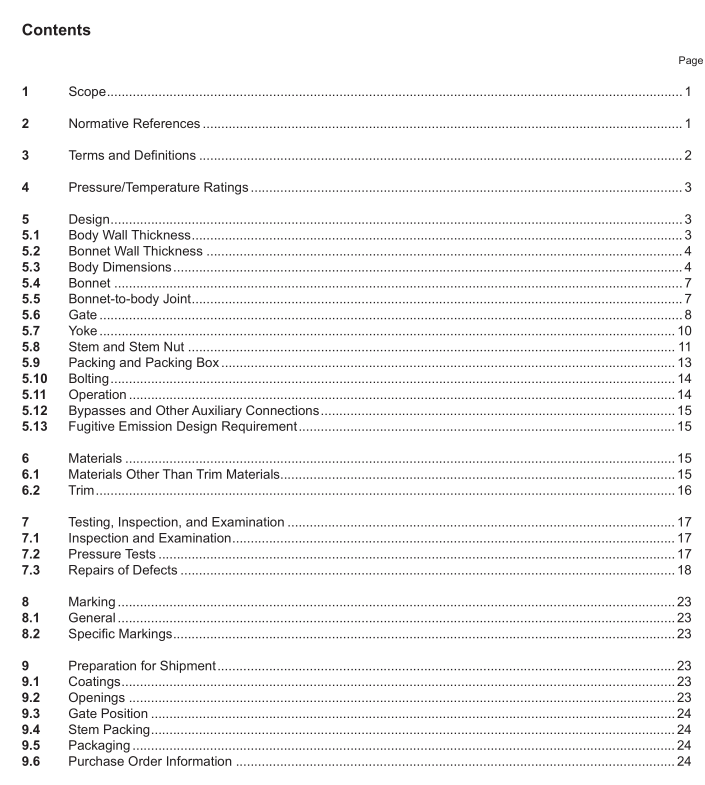API St 600 pdf download

API St 600 pdf download Steel Gate Valves—Flanged and Butt-welding Ends, Bolted Bonnets
3.2DN
A numeric designation of size that is common for components used in a piping system and used for referencepurposes,comprising the letters “DN” followed by a dimensionless number indirectly related to the physical sizeof the bore or outside diameter of the end connection as appropriate. The dimensionless number following “DN”does not represent a measurable value and is not used for calculation purposes, except where specified.
3.3
NPS
A numeric designation of size that is common for components used in a piping system and used for referencepurposes,comprising the letters “NPS” followed by a dimensionless number indirectly related to the physical sizeof the bore or outside diameter of the end connection as appropriate. The dimensionless number may be used asa valve size identifier without the prefix “NPs” The dimensionless size identification number does not representa measurable value and is not used for calculation purposes.
3.4
shell
Comprised of the body, bonnet, and body-bonnet bolting that constitute the pressure boundary of an APl 600valve.
4Pressure/Temperature Ratings
4.1Pressure/temperature ratings shall be in accordance with those specified in the tables ofASMEB16.34 forstandard class for the applicable material specification and the applicable class.
4.2Restrictions of temperature and concurrent pressure, or pressure and concurrent temperature (e.g., thoseimposed by special soft seals or special trim materials), shall be marked on the valve identification plate (seeSection 8).
4.3The temperature for a corresponding pressure rating is the maximum temperature of the pressure-containing shell of the valve. In general, this temperature is the same as that of the contained fluid.The use of apressure rating corresponding to a temperature other than that of the contained fluid is the responsibility of theuser.
4.4For temperatures below the lowest temperature listed in the pressure/temperature tables, the servicepressure shall be no greater than the pressure for the lowest listed temperature. The use of valves at lowertemperatures is the responsibility of the user.Consideration should be given to the loss of ductility and impactstrength of many materials at low temperature.
NOTE For valves capable of trapping fluid, resulting in center cavity overpressure , refer to ASME B16.34 for a provisionrelated to this requirement.
5 Design
5.1 Body Wall Thickness
5.1.1 A valve body schematic is shown in Figure 1.The minimum body wall thickness,t. , at the time ofmanufacture shall be as given in Table 1, except as indicated in 5.1.2 for butt-welding valve ends.Additionalmetal thickness needed for assembly stresses,stress concentrations, and shapes other than circular shall bedetermined by individual manufacturers, since these factors vary widely.
5.1.2 The weld end preparation in butt-welding end valves (see 5.3.2) shall not reduce the body wall thickness to less than the values specifed in 5.1.1 within a region closer than t m to the outside surface of the body neck, measured along the run direction. The transition to the weld preparation shall be gradual and the section shall be essentially circular through the entire length of the transition. Sharp discontinuities or abrupt changes in section in areas that infringe into the transition shall be avoided, except that test collars or bands, either welded or integral, are allowed. In no case shall the thickness be less than 0.77t m at a distance of 2t m from the weld end.
5.2 Bonnet Wall Thickness The minimum bonnet wall thickness at the time of manufacture, except for the neck extension that contains the packing, shall be t m as given in Table 1. For the neck extension, the local minimum wall thickness shall be based on the local diameter, e.g., the inside diameter of the stem bore or packing box bore, and shall be in accordance with the valve body neck rules of ASME B16.34.
5.3 Body Dimensions
5.3.1 Flanged Ends
5.3.1.1 Body end fanges shall comply with the dimensional requirements of ASME B16.5 for sizes up to and including DN 600 (NPS 24). For sizes over DN 600 (NPS 24), body end fanges shall comply with the dimensional requirements of ASME B16.47 Series A or Series B as specifed by the purchaser. Unless otherwise specifed, raised face end fanges shall be provided. The purchaser may specify a fange facing fnish other than that specifed in ASME B16.5 or ASME B16.47, as applicable.
5.3.1.2 Face-to-face dimensions shall be in accordance with ASME B16.10 or ISO 5752. For sizes not listed, dimensions shall be as agreed to between purchaser and manufacturer. Body end fanges and bonnet fanges shall be cast or forged integral with the body. However, fanges may be attached by welding when approved by the purchaser.









